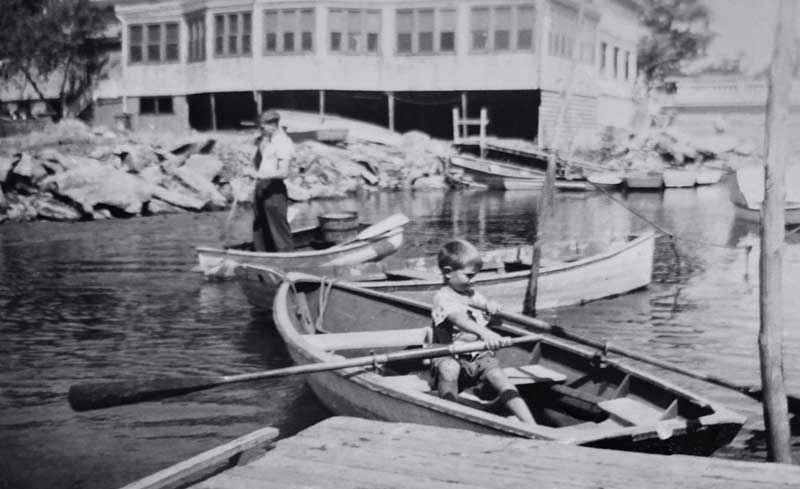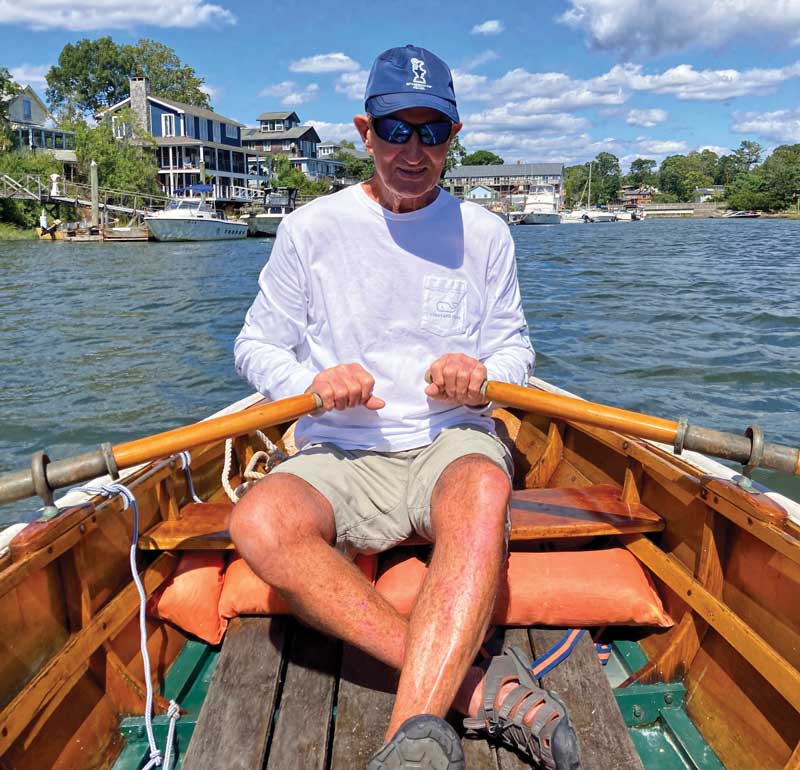 The author at the age of four, “under way, but not under way,” secured to the dock at Talmadge’s Boat Yard, Farm River. Photo courtesy William Clapp
The author at the age of four, “under way, but not under way,” secured to the dock at Talmadge’s Boat Yard, Farm River. Photo courtesy William Clapp
My greatest pleasures have come from sailing, building, and maintaining wooden boats. Nowhere is this as firmly rooted in the coastal culture of communities as in Maine. My middle name, Ellsworth, places my family’s roots in Hancock County, and the family tree traces past generations to Beals Island. My story starts, though, in Connecticut, where I was born and rowed my first boat at the age of four on the Farm River 82 years ago.
History runs deep there. In 1614 the Dutch privateer, trader, and ship’s captain Adriaen Block explored the tributaries of the Connecticut shoreline. Evidence of trading posts and early settlements have been found east of the Farm River on the Branford shoreline. The “Dutch Wharf House,” a trading post on the west side of the Branford River, was most likely a port of call for the schooner Stephen Tabor, built in 1871 on Long Island, New York, and now part of the windjammer passenger trade out of Rockland, Maine. Her memory has been kept alive in a carving of her under full sail on a large entrance sign that I created for the Dutch Wharf Boatyard.
My mother taught me to respect the power of the sea and to “keep a weather eye on your surroundings.” She spent much of her early childhood at the Point Judith Lighthouse in Rhode Island, where my grandfather was lighthouse keeper from 1911-1918. High seas and heavy fog were common. The rocky bottom south of the point, often referred to as Squid Ledge, and the breakwaters forming the harbor of refuge for coastal shipping were the scenes of many shipwrecks. In 1911 this was a lonely outpost. My mother remembered a “long walk to the one room schoolhouse.” The family frequently slept close to the coal stove in the kitchen, which was supplied with coal washed up from wrecked schooners.
My mother’s stories of shipwrecks and southerly gales kept me in awe of nature’s strength. Severe northeast gales in the winter with heavy snow and ice would drive coasting schooners ashore or against the breakwaters, she recalled. In some wrecks the crews would climb the rigging to escape being drowned, and if not rescued, they would perish in place, frozen in the rigging. My mother witnessed rescues made by breeches buoy and surfboat. The main message was always how dangerous these operations were and how powerful the sea was in every season.
This advice remained with me as I ventured farther from our dock on the Farm River and beyond. At a young age, I would use my awareness of the weather to decide whether it was better to go crabbing or to set sail. I watched for afternoon thunderstorms and kept a close eye on the tides. I am told that my first two words were “high tide.”
My story of growing up on the Farm River would not be complete without the presence of Nellie Green Talmadge, the “Bootlegger Queen of Connecticut.” An expert horsewoman, trained opera singer, and astute businesswoman, her life was centered on the Farm River. Her work crew included “Wing” St. Clair, the leader of her rum-running fleet, who made rendezvous with the likes of Bill McCoy (the real McCoy), and was known for delivering the best “uncut” liquor during Prohibition. I remember him as an expert seaman, boat handler, local folk hero, and storyteller. She married her childhood sweetheart, William Barnes Talmadge, who was a boatbuilder in his younger years. I would help bail out his boats and assist with repairs as he worked to keep the couple’s fleet of rental boats in order.
After messing about with oars, I thought it would be neat to try sailing at the age of nine. Poking around the old sheds in the Talmadge Boat Yard, I came across a small mast, boom, and rudder. A set of leeboards from an Old Town canoe were donated by an old timer; a friend of my mother’s sewed a sail on her foot-powered Singer sewing machine. There was a great deal of experimenting with leeboard positioning, sail trim, and placement of my body weight as I learned through trial and error.
I was allowed to sail to the mouth of the river and into the Farm River Gut.
As a gift for my twelfth birthday, I received subscriptions to Yachting and Rudder magazines, which I devoured page by page, searching for my next boat. I saved up $400 earned from blue crab sales and boat bailing, which was just enough to buy a 21.5' gaff-rigged sloop, a semi-abandoned beauty that required daily pumping. The owner was eager to sell her to someone who would “save her.” I pleaded my case to my parents and to the owner that I would be able to keep her afloat and get her sailing again. After a call to the E.M. Crosby Boatyard on Cape Cod, she was identified as a Wianno Junior, a predecessor to the wonderfully popular Wianno 25. I named her Puffin. With cotton sails, tired manila running rigging, a bucket, and a fisherman’s style hand bilge pump, she was my dream boat.
All my energy was directed to getting her ship-shape. For guidance I went to Ed Kelsey who established the Kelsey Boat Yard in 1936 in the Short Beach section of Branford, with its marine railway on the north edge of the Farm River Gut and dockage on the Farm River. He was a patient and skilled boatbuilder who gave me advice and confidence for my project. Puffin carried me through my high school years, sailing and cruising Long Island Sound, and Gardiners and Peconic bays. One memorable afternoon, I came upon the grand schooner Nina on a broad reach, mid-sound, heeling just so, with a 15-knot southwester filling her huge gollywobbler. Owner DeCourtsey Fales was sitting to leeward with one hand on the center spoke of the wheel and the other holding a big cigar. He shouted that he was bound for Newport to race to Bermuda. She appeared to literally fly by me. That was my siren call to one day race to Bermuda.
After a stint in the Navy to fulfill my commitment after New York Maritime College, I was fortunate enough to build a house tucked within the north edge of the Farm River Gut. There my wife and I raised a son and daughter, introducing them to the water and sailing at a young age. Both turned into strong swimmers and able hands.
During this time, I also found berths on a variety of sailboats as navigator for coastal and around-the-buoy racing. In 1979 I was invited to my first of 15 races to Bermuda as navigator in the Marion-Bermuda race. I dusted off my sextant, and we managed a second-place finish in class. From then on, I raced in Newport-Bermuda on the even years and Marion-Bermuda on the odd years. I sailed the Newport-Bermuda races of 1992, 1994, and 1996 aboard the Concordia Yawl Dame of Sark.
A golden handshake in 1987 allowed me the time to do a lot more sailing. I managed to convince the owner of the Dutch Wharf Boat Yard that I could make a contribution to his business, especially paying attention to his wooden boat customers. This led to 20 years of doing what I loved—hanging around a boatyard and sailing! My job in the yard involved working inside in the winter and delivery trips to and from the yard in the summer. It gave me annual invites to sail to and from Maine and participate in the Eggemoggin Reach races aboard Lueza, an Aage Nielsen-designed 40' sloop that summered at North Haven island and returned to the yard each year for winter storage.
A flexible work schedule led to a boat project with H & H Boatbuilders in Steuben, Maine. I made bimonthly inspection trips to meet with yard owner Terry Hutchens for a project involving the conversion of a 40' Osmond Beal lobsterboat hull into a passenger ferry for the Bitter End Yacht Club in the British Virgin Islands. She was beautifully executed, topped out at 30 knots in sea trials, and proved to be an excellent sea boat.
At that time, I had the perfect boat: Tern was an L. Francis Herreshoff Rozinante, built by Lie Nielson in Rockland, Maine, in 1974. I owned her for almost 20 years. She was one of the rare boats that provides that special feeling through the tiller as she beats to windward of being one with the boat.
 The author rowing the route of the old rum runners to Nellie Green’s Hotel Talmadge, summer of 2021. Photo courtesy William Clapp
The author rowing the route of the old rum runners to Nellie Green’s Hotel Talmadge, summer of 2021. Photo courtesy William Clapp
While tacking out of the Farm River last summer in a small pram, I reflected that my first act of shipping oars in a row boat some 80-plus years ago led me on a memorable and rewarding journey. Most of my mentors have “crossed over the bar,” and I feel grateful to have had their guidance. Terns still dive for fish in the Farm River, Gut, and Granite Bay. Johnson’s Boat Yard in Granite Bay is now the home of the Yale Corinthian Yacht Club. The once quiet waters of the Farm River estuary are now invaded by jet skis and outboards. Few blue crabs remain.
Over the years I have collected quotations related to the water and tides, including this one from an unknown source: “Lessons learned early on: that one has to adapt to conditions on the water to safely arrive at a chosen destination with the vessel and oneself intact.”
William E. Clapp is still invited to crew on the classic 68 foot yawl Black Watch and makes annual visits to the Wooden Boat Festival in Port Townsend, WA. His love and respect for the water, wooden boats, and the history of yachting are an integral part of his active life.






